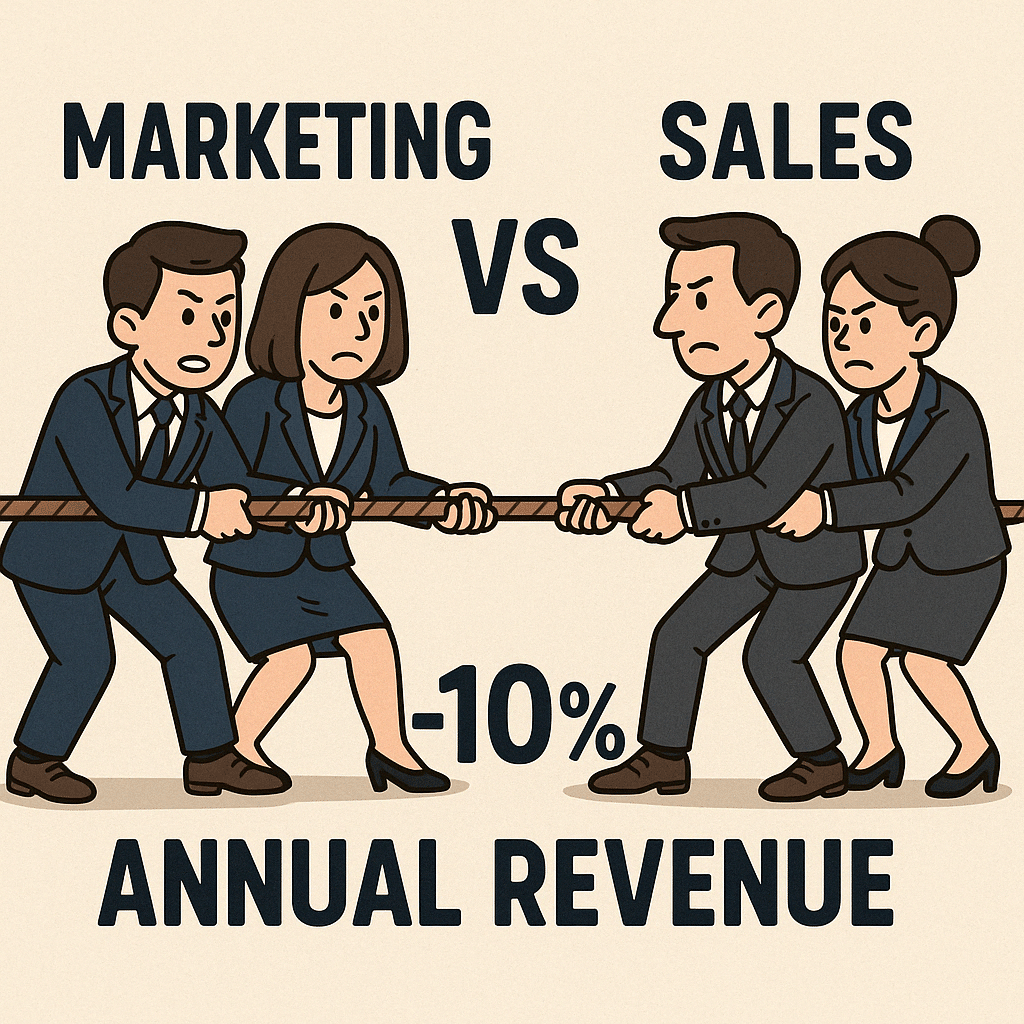
In large B2B companies, marketing and sales teams continue to operate in silos, resulting in wasted resources and missed opportunities.
Marketing complains that sales ignores their hard-earned leads. Sales complains that marketing leads are garbage. Neither team trusts the other’s data or priorities.
Sound familiar? This disconnect is expensive. Sales and marketing misalignment costs businesses 10% or more in revenue annually, per ZoomInfo.

But there’s a new technology in the shed that marketers and sellers are anxiously learning and could be the saving grace: artificial intelligence.
AI fundamentally reshapes how marketing and sales work together. For those adopting traditional ABM frameworks, look to modernize from static account lists, third-party data dependencies and limited personalization to allow for an AI-powered future.
What’s required is a modernization of marketing and sales that places AI at the center of your people, processes and technology. When implemented correctly, AI doesn’t just improve alignment, it makes alignment inevitable by creating a single, data-driven source of momentum that both teams trust and act on.
People: Unlocking creativity and collaboration through AI
The most immediate impact of AI is freeing your teams from manual, repetitive tasks that drain creativity and reinforce silos.
- Marketing teams spend countless hours building target account lists, researching prospects and personalizing messages.
- Sales reps waste valuable selling time prioritizing accounts, logging activities and crafting follow-ups.
These mundane tasks kill morale and reinforce the perception that both teams are too busy to collaborate. AI changes this equation.
- When marketers use generative AI for content creation, they produce 10 times more personalized content without increasing headcount.
- Sales teams using AI-powered research spend far less time preparing for calls and much more time actually engaging prospects.
This shift creates space for what humans do best: creative strategy, relationship building and collaborative problem-solving. When a marketer instantly generates account-specific messaging that actually works and a sales rep immediately sees which accounts are showing buying signals, the traditional friction points begin to dissolve.
The key is using AI to create a shared experience. In the modern, account-based approach to marketing and sales, teams aren’t passing leads back and forth. They’re collaboratively developing account strategies based on a unified view of data and engagement. AI becomes the accelerator and bridges the teams together, offering a neutral ground for teams to ideate and collaborate.
Dig deeper: Why AI proficiency is today’s must-have marketing skill
Process: From handoffs to orchestration
Traditional lead management follows a linear assembly line, where marketing:
- Generates leads.
- Qualifies them through scoring.
- Hands them to sales for follow-up.
This creates an inherently adversarial relationship, with sales rejecting “bad” leads and marketing complaining about poor follow-up.
AI enables a fundamentally different approach: signal-based orchestration. Rather than focusing on lead status or MQL criteria, AI analyzes thousands of signals across accounts, the buying group and contact engagement behavior. These signals inform a dynamic, account-level view of readiness that triggers coordinated actions from both marketing and sales.
When an AI system detects that multiple stakeholders at an account are displaying the behavior of your best customers last quarter, it doesn’t just add points to a lead score, it creates momentum. Marketing can then deploy the right tactic to the right person in the buying committee and prepare sales to receive a customer signal with recommended outreach and talking points.
This process transformation eliminates the age-old complaint: “Sales isn’t following up on my leads.” Instead, both teams engage accounts based on the same AI-interpreted signals, creating a seamless customer experience while driving better conversion rates.
The most advanced organizations are taking this further by implementing AI agents that handle routine orchestration automatically. With little human intervention, these systems:
- Analyze engagement data.
- Prioritize accounts showing buying signals.
- Trigger personalized sequences across channels.
Dig deeper: Is your marketing team AI-ready? 8 steps to strategic AI adoption
Technology: AI-native applications reimagining the martech stack
The technology landscape for modern marketing and sales is undergoing a revolution. Traditional marketing automation platforms and CRMs weren’t designed with AI at their core, creating integration challenges and data silos that perpetuate misalignment.
A new generation of AI-native applications is emerging to address these limitations:
- Contact and account intelligence platforms like Clay and Ocean.io are replacing traditional data providers. They use AI to continuously discover, enrich, and validate account information in real time.
- Content generation tools like Copy.ai and Jasper are enabling the creation of hyper-personalized messaging that adapts based on industry, role and buying stage signals.
- Applications like Mutiny can generate thousands of personalized landing pages at scale.
- Unify and GrowthLoop are breaking down data silos by integrating first-party and third-party signals into unified customer data platforms that both marketing and sales can trust.
- Conversation intelligence platforms like Gong and Chorus analyze sales calls to extract insights that inform marketing messaging and content strategy, creating a continuous feedback loop.
- ABM platforms like 6sense and Demandbase now use AI agents to identify in-market accounts, prioritize outreach and coordinate multi-channel campaigns while integrating seamlessly with sales engagement tools.

These technologies use AI to eliminate manual data entry, subjective scoring, and clunky campaign execution. The natural result is less friction between marketing and sales.
Principles for AI-driven alignment
As you consider adopting AI to improve marketing and sales alignment, focus on these strategic principles:
- Start with a unified data infrastructure. AI is only as good as the data it learns from. Before investing in advanced AI applications, ensure your first-party data is centralized, clean and accessible to both teams.
- Redesign processes around signals, not stages. Move beyond linear handoffs to create orchestrated experiences triggered by real account behavior. Define which signals matter most and build playbooks that coordinate marketing and sales responses.
- Prioritize transparency and explainability. AI shouldn’t be a black box. Both teams need to understand why accounts are being prioritized and what signals are driving recommendations.
- Invest in skills, not just tools. Technology alone won’t drive alignment. Create learning opportunities for both teams to understand AI capabilities and limitations while fostering a culture of experimentation.
- Measure joint outcomes. Replace siloed metrics with shared KPIs focused on account progression, engagement depth and revenue impact. What gets measured together gets solved together.
The future of marketing and sales alignment isn’t about better meetings or clearer SLAs, it’s built on how these teams will collaborate in an AI-driven world. Organizations that embrace these modern principles while thoughtfully implementing AI will improve alignment and create a sustainable competitive advantage that traditional approaches simply cannot match.
Dig deeper: How to unlock the true potential of AI with adaptive structure
The post Could AI be what finally aligns marketing and sales teams? appeared first on MarTech.
